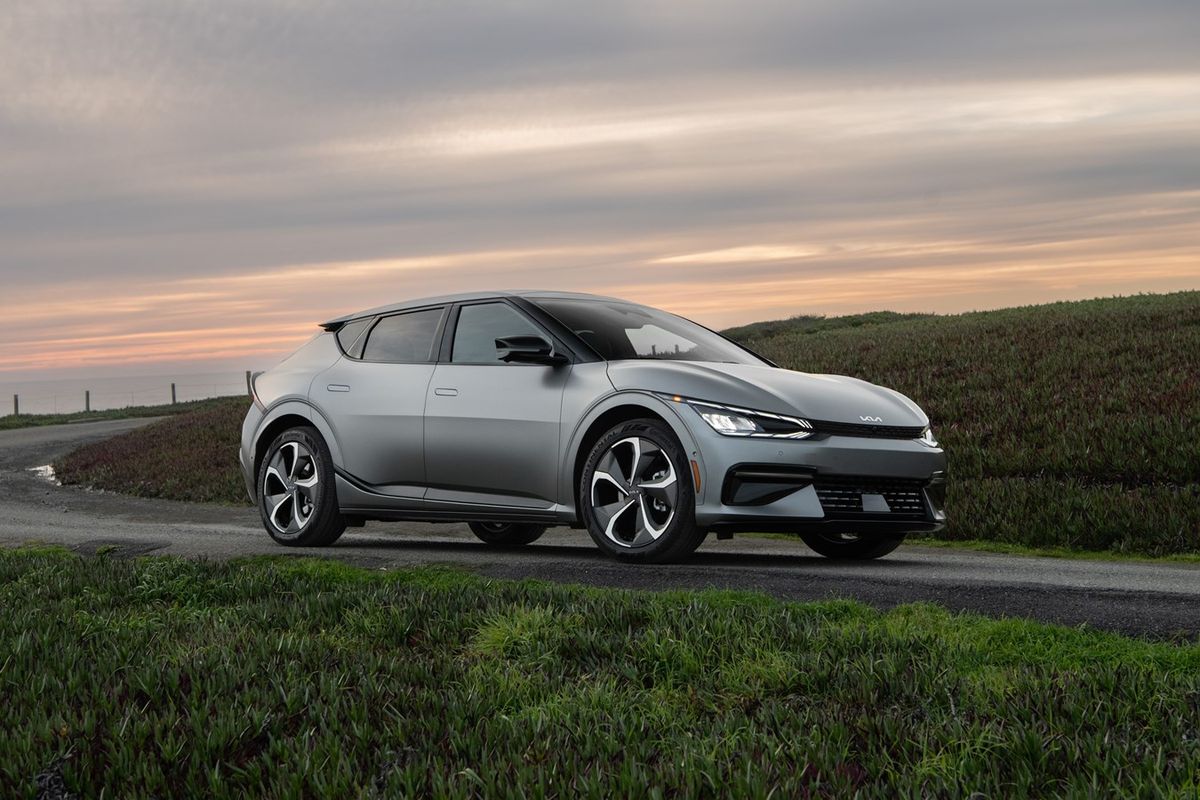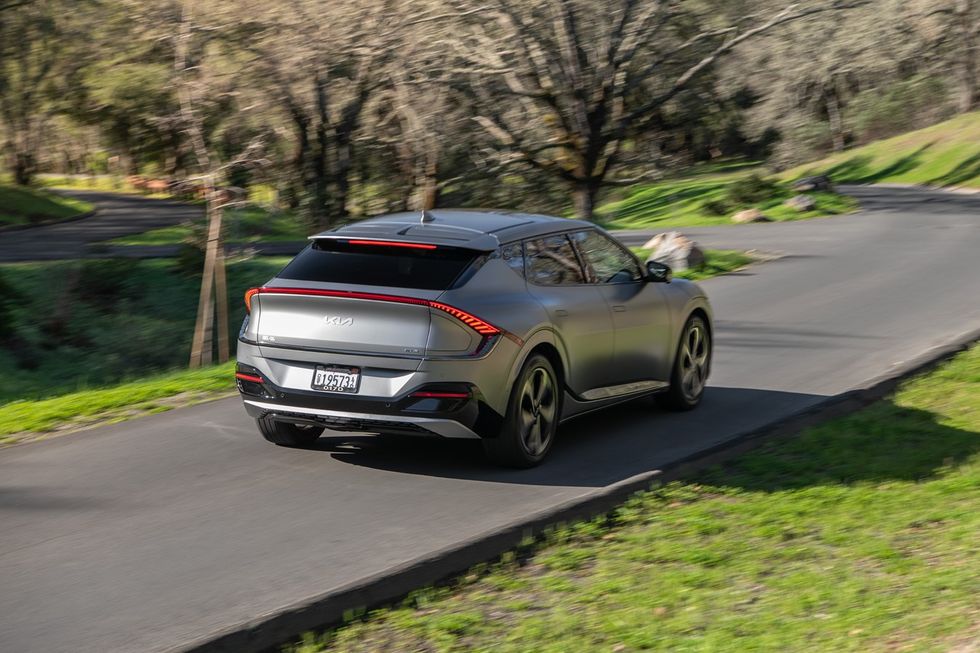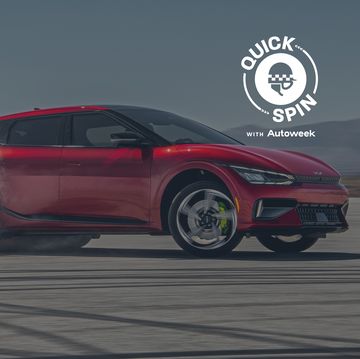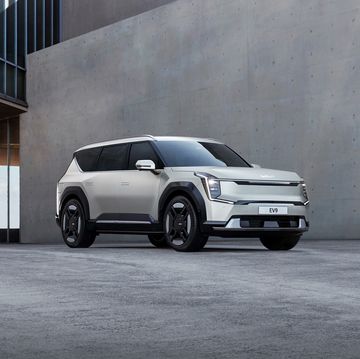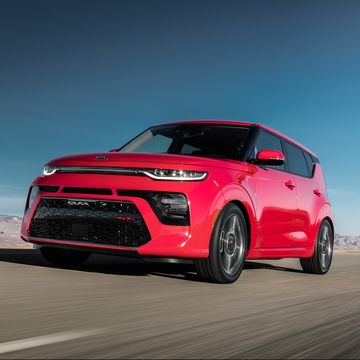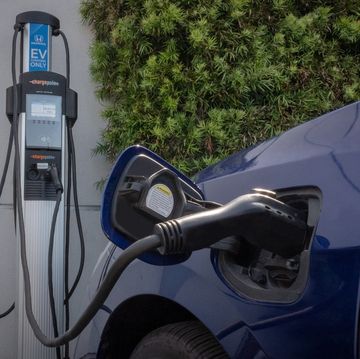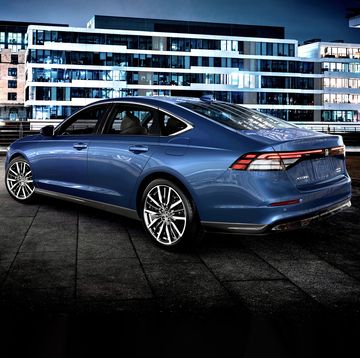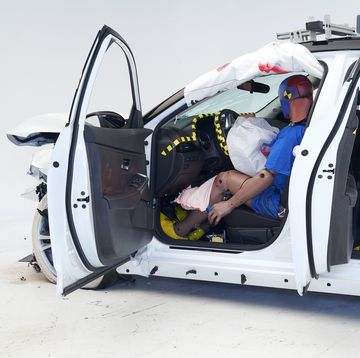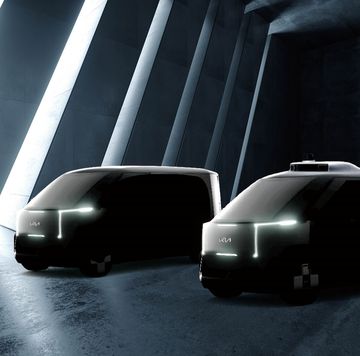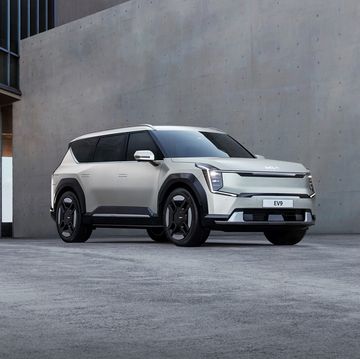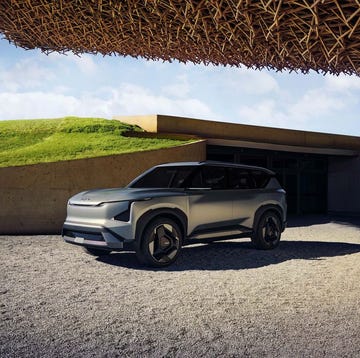- The 2022 Kia EV6 is the second vehicle in the Hyundai Motor Group’s portfolio to ride on the corporate E-GMP electric-vehicle platform, following the launch of the Ioniq 5 in December.
- The EV6 has an estimated range of 310 miles in rear-wheel-drive versions with the bigger 77.4-kilowatt-hour battery, with the more affordable 58-kWh version seeing 232 miles.
- Pricing for the base model rear-drive EV6 Light starts at $42,115, and with top-line all-wheel-drive EV6 GT-Line models starting at $57,115. EV6s should be rolling into showrooms in a few weeks.
It’s been more than two years since Hyundai executive vice chairman Euisun Chung announced that the company’s three brands—Hyundai, Kia, and Genesis—will introduce 23 new pure electric vehicles by 2025. Hyundai broke the ice with the first US sales of the Ioniq 5 in mid-December. Now, Kia arrives at the EV party with the Kia EV6.
While the Hyundai Ioniq 5 is an angular SUV with a sci-fi vibe, the Kia EV6 design aims for widespread appeal. It uses conventional curves to convey sportiness in a more sedan-like crossover. Both companies rely on the same powertrain, charging system, and battery packs—courtesy of Hyundai’s Electric-Global Modular Platform (E-GMP). Beyond that, it’s a battle to see who can more effectively win over consumers who say they want an electric vehicle but have been waiting on the sidelines. Kia executives told us that about 70 percent of Kia EV6 buyers would be new to electric cars.
Media images of the sleek Kia EV6 give the impression of a taut, muscular hatch. But approaching the Kia in person dispelled that notion. Yes, the Kia is a few inches lower and shorter than its Hyundai electric sibling. It’s nearly 170 pounds lighter as well. However, the EV6 is surprisingly long and spacious. The scale and proportions are well-sized for family duties that a wagon answered in previous generations.
From the inside, the EV6 doesn’t feel anything like an SUV. There’s no high perch from the driver’s seat. Instead, we peered over a short front end—with a generous passenger space trailing behind. Even with the front seat slid back for my 6-foot-4-inch frame, there was ample space for second-row adult passengers. I bumped my head the first time I squeezed through the rear door opening, but you can’t blame Kia designers for my klutziness.
If you’re keeping score against prime competitors, the Kia EV6 is 4.3 inches longer, 1.1 inches wider, and has a 5.3-inch longer wheelbase than the Volkswagen ID.4. The EV6 is barely shorter and narrower than the Ford Mustang Mach-E and Tesla Model Y.
Kia’s strategy is to offer just enough space, performance, and high-tech goodies while maintaining a laser focus on what American consumers say their first EV must have: maximum range. “The more SUV you add to the car, the less estimated range you get,” said Steve Kosowski, manager of long-range planning at Kia America. “If we stiffen the front end, give it more ground clearance and bigger tires, the range would be cut. Hitting the 300-mile mark all comes down to the right balance.”
Kia beat that bogey, earning an estimated range of 310 miles in rear-wheel-drive versions with the bigger 77.4-kilowatt-hour battery. Forget that 300 miles far exceeds the daily needs of American drivers or that the all-wheel-drive variant slips to 274 miles—and the more affordable 58-kWh version earns a 232-mile rating. The marketing of a 300-plus mile option is an invitation to worry-free electric mobility. Come on in. The water’s fine.
Similarly, the EV6’s 800-volt architecture means the Kia electric vehicle can add an estimated 217 miles of range in 18 minutes—when plugging into an ultra-fast 350-kW highway charging station. That’s effectively the same refueling time as a highway stop at a gas station. Never mind that about 90 percent of charging takes place at home. With the EV6, Kia dismantles objections, one after the other, to EV adoption.
Kia is only the second automaker to deliver the 800-volt capability. The Porsche Taycan electric sports car was the first.
Our half-day in the EV6 did not allow enough time and distance to test the range or recharging. But a few hours from behind the wheel revealed the vehicle’s driving manners. We split our time between the 225-horsepower rear-wheel-drive version and a 320-hp all-wheel-drive variant. Even when put into Sport mode, neither one produced the tire-chirping excitement you might expect from its sleek design.
As an EV enthusiast who enjoys the rocket-ship launches from a Tesla Model S Plaid or Ford Mustang Mach-E GT Performance vehicle, I want to get thrown back in the seat. The mapping of the go-pedal delivering the EV6’s 320 horses was tame in comparison. The EV6 is not slow, but it cautiously unfurls power to, once again, protect all-important range.
EVs come automatically with a high torque that most drivers of gas cars will find remarkable. So, Kia doesn’t deliver wallops of acceleration, instead allowing the exterior design to convey sportiness. The jet-fighter audio track piped into the cabin during rapid acceleration completes the impression.
For my taste, I would have preferred faster sprints to the warp-speed soundtrack. Some of Kia’s styling also tries too hard. For example, the “road blade” visual line traveling from the door sill to the rear spoiler won’t be to everyone’s taste. The dashboard’s busy graphics and interface design also emphasize visual razzle-dazzle over refinement and ease of use. On the other hand, Kia deserves kudos for equipping the EV6 with the ability to power appliances, such as laptops or blenders, via an interior outlet and the charge port. That add-on could come in handy.
If the EV6 is aimed at mass appeal, you might wonder about the price tag. The small-battery, 232-mile variant starts at $42,115—almost $1200 more than the Hyundai Ioniq 5’s starting price. But the more desirable and likely more popular 310-mile GT-Line RWD version begins at $52,415 and climbs higher with more goodies.
Kosowski explained the rationale. His tracking of average EV prices shows that a decade ago, non-Tesla EVs—such as the Nissan LEAF—cost about $30,800. At that time, the average Tesla sold for about $92,000. With the arrival of the Model 3, average Tesla transactions fell to just above $60,000 by 2019—and settled around $56,600 in 2021. Meanwhile, as other automakers introduced electric vehicles, non-Tesla EV transactions prices rose to $49,700 by 2021.
To repeat: Average EV transaction prices across the market are converging on $55,000, barely above the typical price tag of all vehicles. Any remaining premium for the EV6 is wiped out by a $7500 federal tax credit.
In other words, the long-held belief that EVs would become mainstream only when a long-range model had a price tag of $30,000 is no longer true. EVs now go for $50,000 to $55,000, and nobody blinks. That’s where most Kia EV6s will likely sell—especially while supplies are limited.
Russell Wager, vice president of marketing, Kia America, acknowledged that the global capacity of the EV6 will be 100,000 units in the first year, and there will be fierce competition from other markets. “It’s selling well in Korea. It’s selling well in Europe, and it’s anticipated to sell well here,” said Wager. He’s also keenly aware that EV sales are on a rapid ascent. “Last quarter, the EV market was four and a half percent, so more people want EVs. That adds more pressure.”
The Kia EV6 represents a bold pivot for Kia to electric vehicles, much like the sporty Kia Stinger a few years ago showed how the brand could shed its econobox heritage. Moreover, the EV6 demonstrates that the brand can deliver a highly competitive, stylish, long-range, fast-charging battery-powered vehicle in the most popular crossover segment.
There’s every sign that Kia, in coming years, will transplant the EV6’s attributes and capabilities to a larger all-electric full-size SUV and then a smaller zero-emissions hatch. (Perhaps an EV9 and EV3, respectively.) The EV6 carves Kia’s place in the all-important electric market. “We have a whitespace for the EV6 that we think is different than Hyundai, Volkswagen, or the Ford Mustang Mach-E,” said Wager. “We found the place that appeals to a younger, more affluent audience. That’s our differentiator.”
Share your thoughts on the Kia EV6, its design, and its price point in the comments below.
